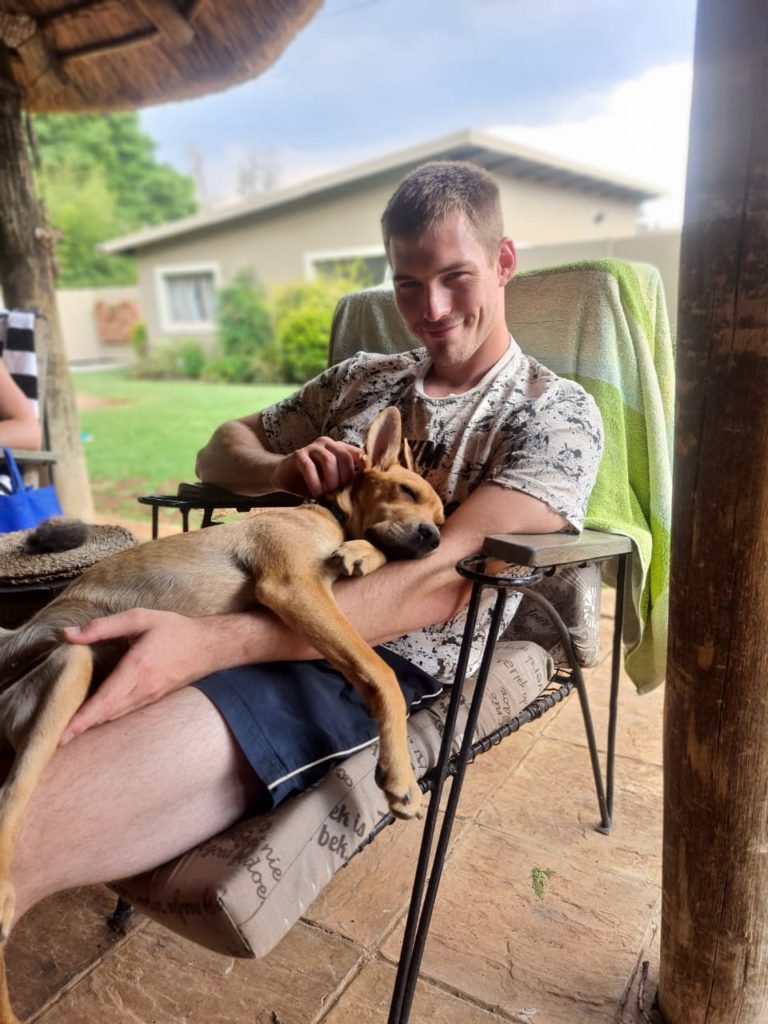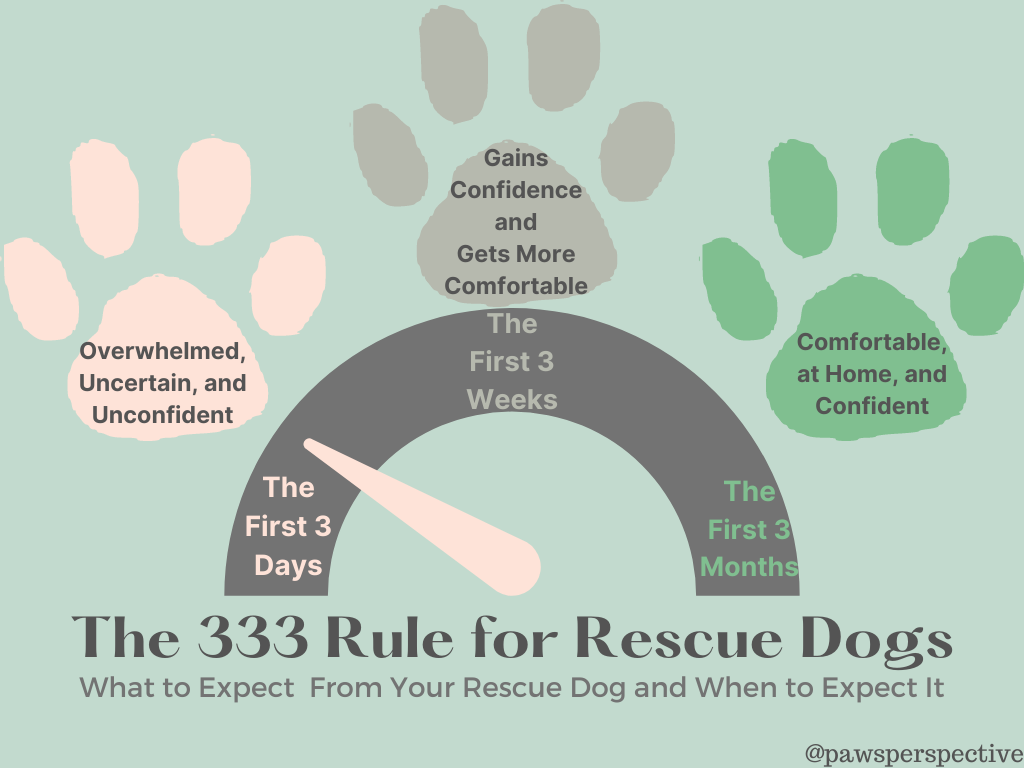When it comes to rescuing dogs, we don’t always know what they’ve been through before getting to the animal shelter. We can’t be sure whether they’ve had unfortunate circumstances or abusive owners. So, naturally, a concern arises about how fast these dogs will adjust to their new lives.
On average, it takes rescue dogs four weeks to 3 months to adjust and get comfortable in their new homes. Because your home and routines are new to this four-legged friend, they need time to figure out the lay of the land. It doesn’t happen overnight.

Unfortunately, these bad experiences shape what these dogs expect out of life. It’s not like getting a puppy that doesn’t have any previous experiences shaping their idea of life. You’re getting what someone else saw as “damaged goods” and who abandoned the poor creature. They still need to learn that there are good owners out there and that you’re one of them.
Why it Might Take a While for a Rescue Dog to Adjust
Rescue dogs come in all shapes, sizes, breeds, and backgrounds. And with most of them, the rescue shelters can’t be sure what these dogs went through in their previous homes. Some of these dogs didn’t even have homes and fend for themselves in the streets. And all of these factors will determine how quickly they get used to your way of living.
It might take longer for rescue dogs to adjust because:
- They are not used to your routines,
- These dogs are not sure whether this new home is permanent,
- Some of them have anxiety about being alone,
- They fear being abandoned again,
- Most dogs need time to figure out how things work now,
- Some dogs need time to trust their new owners,
- These dogs are not used to the smells and sound in this new home,
- They need to gain back lost confidence, and
- Still, remember the terrible experiences they went through, and something you do might trigger that fear.
So, be patient with these dogs. They’re doing what they know will best assure their survival. It’s like a set mindset that needs to change. Their perspectives will only change over time as they learn that life isn’t as scary as they remember it to be.
Story Time…
I’ve had a colleague (in the engineering manufacturing industry) who adopted a dog with his wife. They asked me what to do about the dog because she was crying whenever they would go to work. I told them that getting the dog comfortable with her new surroundings would take time, patience, training, and lots of love.
Unfortunately, they weren’t prepared for that level of effort and gave the dog back up for adoption. This broke my heart because people don’t realize the trauma the poor dogs go through when they’re given up for adoption.
No wonder rescue dogs take longer to trust that their new surroundings are permanent. They’ve gone through countless stressful situations and might fear abandonment repeatedly. And no wonder they act out now and again.
I urge anyone who considers adopting a dog to be prepared for the time, patience, effort, and love it takes to gain these dogs’ trust. It might be a long process, but you have a fur friend for life once they get comfortable with you!
Juan’Ri Strauss
What is the 333 Rule for Rescue Dogs?
If you’re considering adopting a dog (or have done so already), you might have heard about the 333 rule for rescue dogs. It’s an excellent tool to help manage your expectations of your new fur friend. The more you know about what to expect, the more prepared you will be to handle the more challenging situations.
The 333 rule for rescue dogs refers to the different stages once the dog goes to their new home. It is the dogs’ first 3 days, 3 weeks, and 3 months since you took them home. During each stage, a rescue dog goes through different feelings and behaviors. Then you, as the new owner, can adjust your approach to the dog to help them cope during this new, exciting, and challenging chapter. According to StudyFinds, this method is so effective that “77 percent of rescue-only dog parents find this rule to be true when it comes to their own experiences.”
I don’t personally have a rescue dog, but I have trained many during my dog training days. One universal truth is that when owners know what to expect from these dogs, they have more patience and compassion for what the dogs go through. According to the dog’s stage, they are also more equipped with what to do and when to do it.

A Rescue Dog’s First 3 Days
The first three days for a rescue dog are probably the toughest. Although some might not have been at the shelter for long, others have been there for so long that it became home. So, in a sense, these dogs are taken from yet another familiar place to a new one. It affects their feelings and behavior.
What Your Rescue Dog Feels in the First 3 Days
- Overwhelmed: Going to a new home is a sensory overload for these dogs. There are different smells, sounds, and object that they’re not used to. So, this sudden change might overwhelm these dogs.
- Uncertain: These dogs can be pretty unsure because of possible traumatic past experiences. They’re unsure how to act or what their owners expect of them. Remember, some might have had owners who beat them just because they did ordinary things dogs do.
- Unconfident: Along with uncertainty comes a lack of confidence. This lack of confidence most likely comes from years of not being allowed to be a dog properly. For instance, some dogs don’t know how to play, act in a pack, or feel safe being themselves.
How Your Rescue Dog Behaves in the First 3 Days
- Won’t eat or drink enough water: There are many reasons your rescue dog won’t eat or drink. The most common cause is stress and a change in food and the environment. Give them time. They will adjust. On the other hand, it might be because of an illness. So, if you suspect disease, take the dog to the vet to be safe.
- Shy away: It is common for rescue dogs to keep to themselves and shy away in corners, hiding from you or other family members. They’re most likely scared of what’s happening and need to suss it out from their safe corners. Don’t worry, though. If you stay patient and loving, they will relax.
- Test Boundaries: Most rescue dogs don’t know what boundaries are. They probably didn’t learn how to co-exist in a pack or family and that some rules are in place. So, they might test your boundaries a little. They could enter rooms they’re not supposed to, jump up on people, etc. The secret is to set your boundaries from the get-go.
Dogs thrive on structure, so providing boundaries and gently teaching these dogs what won’t fly in your house. And don’t cave in because you feel sorry for them. You’ll only make future behavioral adjustments more difficult.
Pro tip: start training your rescue dog as soon as they’re comfortable with you. You can start with giving them treats and winning their trust. Once they willingly come to you for treats, start a positive reinforcement training regimen.
Juan’Ri Strauss
If you’re serious about training your new rescue dog with positive reinforcement methods, check out this article explaining the magic it holds!
A Rescue Dog’s First 3 Weeks
After the difficult first three days, the dog will go through a three-week period where they start to settle. Then, they will experience fewer negative feelings and start behaving more like their true selves when three weeks have passed.
What Your Rescue Dog Feels after the First 3 Weeks
- Feel more comfortable: The dog feels more comfortable with how things work in this new environment. They start to recognize the different routines and feel less inclined to shy away during the hustle and bustle of your daily life.
- Realize that this is permanent: Three weeks is an excellent period to show the dog that this situation is permanent. They start to recognize that you won’t abandon them and that they’re genuinely becoming part of the family.
How Your Rescue Dog Behaves after the First 3 Weeks
- Start to show their true personality: Now that the dog is more comfortable, they start to show their true character. This is where you can determine whether they’re calm, bold, playful, intelligent, etc. You can form a remarkable bond with this creature during this time, accepting them for their true selves.
- Adapt to the new routines: These dogs have learned your daily habits in the past three weeks and started to adapt to them. Remember that dogs thrive on routine, so they’ll easily fit into yours after the three-week mark.
- Behavior issues might arise: Because the dog’s true personality starts to show and they’re more confident, they might develop some behavioral issues. It’s not uncommon for rescue dogs to have behavioral problems, so don’t be scared. It takes a little training and positive reinforcement to working on these problems. Some of the more typical behavioral issues you can expect are:
- regression in house training,
- Anxiety,
- Destructive behavior like chewing or digging,
- Aggression
- Anti-social behavior
Again, don’t let this scare you off. It sounds worse than it is. If you take the time to teach your dog what behaviors are acceptable and what aren’t, they’ll learn pretty quickly how to act. They’ll catch on quickly when you do it with love, patience, and positive reinforcement.
A Rescue Dog’s First 3 Months
After the first three weeks, these dogs will slowly ease into their new homes. Some might adapt quicker than others, but generally, the adaption period lasts three months. Then, these dogs are comfortable and adjust to their new role in this new family. Their feelings are more secure, and their behaviors match your routines.
What Your Rescue Dog Feels after the First 3 Months
- Comfortable: These dogs are now comfortable being themselves while knowing which boundaries you’ve set. The nervousness and shying away should have subsided by now, leaving you with a loving companion.
- Trusts the new owners and home environment: The dog learned that you’re not out there to harm them throughout these three months. They start to trust you and their new home, understanding how to fit into your routines. This trust goes a long way in creating a lasting bond with this furry best friend.
- Confident: The dog now feels confident in themselves. Especially if you’ve spent time training them on acceptable behaviors, when dogs know boundaries, feel safe, and meet their needs, they are confident to be the dog they’re meant to be.
How Your Rescue Dog Behaves after the First 3 Months
- Easily fits into the routines: These dogs now easily follow your patterns and even predict them by watching your cues. For instance, they know when you’re going for a walk, when to eat, and when it’s time for bed. They have fully emerged into this new family.
- Learned how to behave in this new environment: These dogs now know what you expect of them throughout your training and keep to boundaries. It doesn’t mean that you should stop with basic training, though. So, keep up the excellent work! Your fur friend will thank you in the long run.
The Paws Perspective
Rescue dogs take a while to adjust to their new homes. They’re working through complicated feelings and realigning their behaviors to fit into your life, so give them time.
It takes a maximum of three months for a rescue dog to fully adjust to the new surroundings, but once they do, you’ll have a loving best friend for the rest of their lives.
To help your dog adjust, use the 333 rule to know what to expect of these dogs and when to expect them. It will help you change your approach to the dog and make the changeover easier for them.
Even though behavioral issues might arise, you can improve them through training. It won’t always be easy, but it will be worth it. If not for you, then definitely for the dog.
On a personal note: I admire anyone who rescues a dog from a shelter. Not just from me, but from your fur friend as well! You’re providing a loving home to an otherwise miserable creature and changing their lives for the better. So, thank you!
